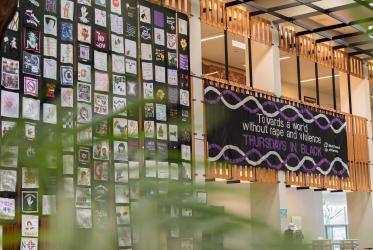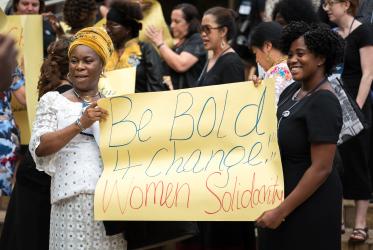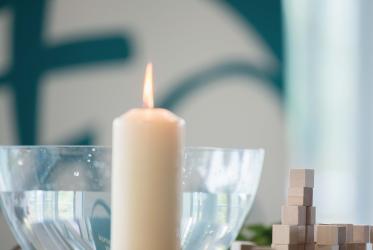“It’s not a vision or a political aspiration bringing these women together—it’s violence,” she said, speaking from her home in Brazil as she finished the 181-block tapestry in time for it to be delivered to the World Council of Churches 11th Assembly in Karlsruhe, Germany.
The project has become not only a work of art but a ministry for Schneider as she visits churches and other groups to talk about what the “Waterfall of Solidarity” stands for: a world without rape and violence.
“Women and men are listening and working on tapestry blocks not to please me—but so that the cry of women can be heard and we can change cultures and attitudes today,” said Schneider.
She has her own story of survival and hope. “I am a woman who was born into a family where my father always regretted that God only gave him women,” she said. “In this family, where I was raised with a lot of love—in a way with love mixed with violence—I was raised to be a wife, mother, and a good housewife.”
Married with four children, she battled depression in the years her children were growing up and leaving home. Three months before she was to graduate from university with a degree in history and archeology, her husband was invited to work in Geneva, Switzerland, at the Lutheran World Federation.
"At the time I thought: Am I going to study other people’s history—or am I going to participate intensely in mine and provide my four children with the possibility to live in other cultures?” reflected Schneider.
She was in Geneva for eight years and, during a particularly difficult time, met a woman who did patchwork every afternoon under the trees in a very beautiful garden in Nyon. “We became great friends,” said Schneider. “We walked together for many years.”
That friendship also opened the doors to the world of patchwork and embroidery for Schneider. “In that world, I discovered another way of living—a very beautiful one.”
As she followed her husband through different cultures, in each culture she went, she took her studio, and her patchwork, and she was able to meet and make many friends. “And then,” she said, “I started working with feminist movements on a small scale.”
But so-called ‘small scales’ sometimes make the biggest impact.
Schneider wants the waterfall to have an impact in Karlsruhe that people remember—and take home with them.
“If they take the essence of this waterfall to the place where they live and can reflect on it, and study it—even better!” she said.
She’s not expecting a simple solution to gender-based violence. She knows firsthand that’s not the way life works.
Yet stitch-by-stitch she believes a better world is coming. “The waters of regrets, hope, love and affection keep flowing through women and men—because men are part of women's history,” she said. “All of them were born of a woman, and they will continue to be born of a woman.”
She concluded: “They, too, have the right to forgive themselves and to start life anew with women—without this horrible thing called femicide.”
Learn more about this exhibition
Carrying women‘s stories of survival and hope, Waterfall of Solidarity and Resistance makes its way to WCC 11th Assembly - WCC news release 3 August 2022








